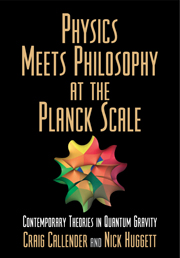Book contents
- Frontmatter
- Contents
- Preface
- 1 Introduction
- Part I Theories of Quantum Gravity and their Philosophical Dimensions
- 2 Spacetime and the philosophical challenge of quantum gravity
- 3 Naive quantum gravity
- 4 Quantum spacetime: What do we know?
- Part II Strings
- Part III Topological Quantum Field Theory
- Part IV Quantum Gravity and the Interpretation of General Relativity
- Part V Quantum Gravity and the Interpretation of Quantum Mechanics
- References
- Notes on contributors
- Index
4 - Quantum spacetime: What do we know?
Published online by Cambridge University Press: 15 December 2009
- Frontmatter
- Contents
- Preface
- 1 Introduction
- Part I Theories of Quantum Gravity and their Philosophical Dimensions
- 2 Spacetime and the philosophical challenge of quantum gravity
- 3 Naive quantum gravity
- 4 Quantum spacetime: What do we know?
- Part II Strings
- Part III Topological Quantum Field Theory
- Part IV Quantum Gravity and the Interpretation of General Relativity
- Part V Quantum Gravity and the Interpretation of Quantum Mechanics
- References
- Notes on contributors
- Index
Summary
The incomplete revolution
Quantum mechanics (QM) and general relativity (GR) have profoundly modified our understanding of the physical world. However, they have left us with a general picture of the physical world which is unclear, incomplete, and fragmented. Combining what we have learned about our world from the two theories and finding a new synthesis is a major challenge, perhaps the major challenge, in today's fundamental physics.
The two theories have opened a major scientific revolution, but this revolution is not completed. Most of the physics of this century has been a series of triumphant explorations of the new worlds opened by QM and GR. QM leads to nuclear physics, solid state physics, and particle physics; GR leads to relativistic astrophysics, cosmology, and is today leading us towards gravitational astronomy. The urgency of applying the two theories to increasingly larger domains, and the momentous developments and the dominant pragmatic attitude of the middle of the twentieth century have obscured the fact that a consistent picture of the physical world, more or less stable for three centuries, has been lost with the advent of QM and GR. This pragmatic attitude cannot be satisfactory, or productive, in the long run. The basic Cartesian–Newtonian notions such as matter, space, time, and causality, have been deeply modified, and the new notions do not stay together. At the basis of our understanding of the world reigns a surprising confusion.
Information
- Type
- Chapter
- Information
- Physics Meets Philosophy at the Planck ScaleContemporary Theories in Quantum Gravity, pp. 101 - 122Publisher: Cambridge University PressPrint publication year: 2001
Accessibility standard: Unknown
Why this information is here
This section outlines the accessibility features of this content - including support for screen readers, full keyboard navigation and high-contrast display options. This may not be relevant for you.Accessibility Information
- 15
- Cited by
